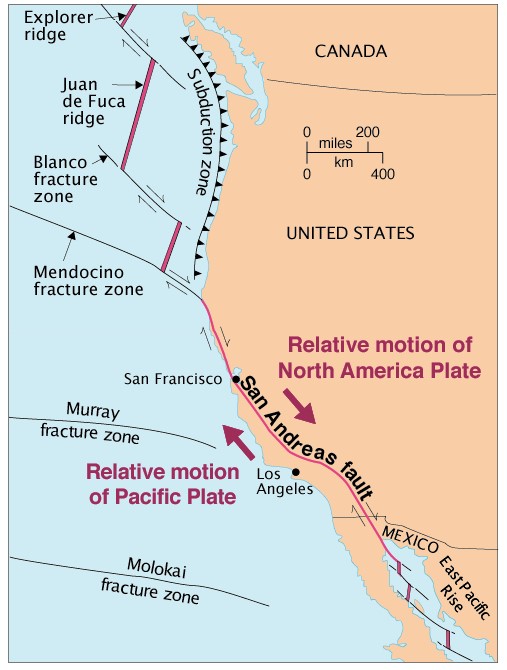Geologic dating helped researchers uncover evidence of big earthquakes along the central San Andreas Fault.
By Jay Barber, science writer (@JayBarber77)
Citation: Barber, J, 2022, A quiet section of the San Andreas once had big quakes, Temblor, http://doi.org/10.32858/temblor.252
The northern and southern sections of the San Andreas Fault have hosted several well-known earthquakes in modern history. In contrast, the middle portion — a 80-mile (130-kilometer) stretch between San Juan Bautista and Parkfield — has remained relatively quiet. However, new research shows that this hasn’t always been the case.

Along much of the San Andreas, earthquakes occur during a dramatic slipping between the Pacific and North American plates. The center section, on the other hand, undergoes slow and constant movement known as “creep,” which prevents a buildup of seismic energy.
Historically, researchers believed this made significant earthquakes on the center section rare. But rock samples from along the fault reveal evidence of several such events in the past. The central section, therefore, may pose a larger hazard than previously thought. Earthquakes that originate on the northern or southern portions of the fault can rupture into the central San Andreas, extending the size and impact of some quakes, said Genevieve Coffey, an earthquake geologist at GNS science and lead author of the study.

Earthquakes turn up the heat
When tectonic plates jolt past each other during an earthquake, friction generates a sudden burst of intense heat. When this happens, organic matter in sediments that make up the surrounding rock can undergo molecular changes, known as “biomarkers.” Biomarkers have been widely used in petroleum industry research, but are a relatively new way to locate past earthquakes. Coffey and her colleagues exploited this phenomenon and found high-heat events in sedimentary core samples drilled out of sections of the fault.
However, earthquakes aren’t the only phenomena that can generate heat, meaning that Coffey and her team needed to verify that the events identified were caused by the movement of tectonic plates as opposed to, for example, the movement of geothermal fluids. To do this, they used potassium-argon dating, which takes advantage of the temperature-dependent cycling of potassium and argon in the rocks.
Under normal circumstances, potassium naturally found in clay and other minerals slowly converts into argon through radioactive decay. The argon accumulates within the clay, and its concentration serves as a timer since the mineral formed. When rocks are subjected to high temperatures, some of the trapped argon is released, thus skewing the calculated age. The researchers found slim bands of rock along the fault that were younger than the surrounding rock, indicating that a short burst of heat partially “reset” rocks along the fault, while leaving those further away untouched. Such localized heating can be due to fault slip during earthquakes.

The core samples reveal that more than 100 earthquakes have occurred in this area within the past 16 million years — some as recent as 3 million years ago. The biggest events reached magnitude 6.9. This is the first evidence of such a large quake in this section, Coffey said.
“You have to have a big slip to make a lot of heat,” said William Ellsworth, a geophysicist at Stanford University. The data indicates a lot of heat, he said. “It looks like the fingerprint of a large slip.” But, he said, the core samples studied come from just one location along the fault. More data will be needed before we know if seismic activity has moved through the full central section of the fault, he said. Because biomarkers analyzed in this study are not found everywhere along the fault, he said, the technique may not work to identify more seismic activity.
Future Central San Andreas quakes
Knowing how this creeping fault behaved in the past indicates how the fault might behave in the future. In this case the research indicates that the center fault has potential to produce seismic activity. The researchers said they recommend their new findings be included in future seismic hazard analysis for the region. Ellsworth said he finds the team’s evidence of large past earthquakes significant, but “the idea that the central creeping San Andreas Fault can rupture in large earthquakes is not a new one.” Geologists consider these past events rare but still noteworthy, he said. Ellsworth points out the seismic hazard model for California “explicitly includes large earthquake ruptures involving this segment of the fault.”

Although Coffey agrees that the geology community has long assumed the central section of the fault may produce seismic activity, she said this new research provides hard data to back up these assumptions. The study could be a step forward because of its use of unique tools. The technique still needs “finessing” to more accurately measure the age of the earthquakes, said Coffey. But more work is being done at the Lamont-Doherty Earth Observatory specifically to improve the potassium-argon dating technique.
References
Coffey, G. L., Savage, H. M., Polissar, P. J., Cox, S. E., Hemming, S. R., Winckler, G., & Bradbury, K. K. (2022). History of earthquakes along the creeping section of the San Andreas fault, California, USA. Geology, 50(4), 516-521.
- Earthquake science illuminates landslide behavior - June 13, 2025
- Destruction and Transformation: Lessons learned from the 2015 Gorkha, Nepal, earthquake - April 25, 2025
- Knock, knock, knocking on your door – the Julian earthquake in southern California issues reminder to be prepared - April 24, 2025
